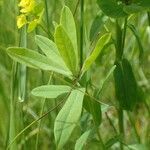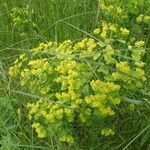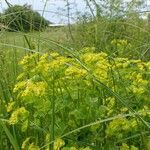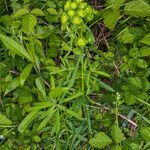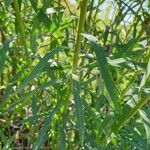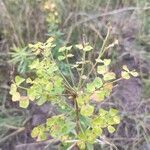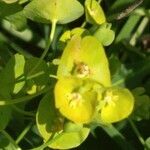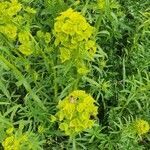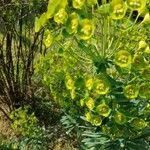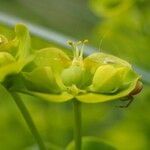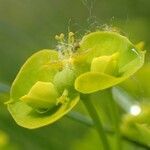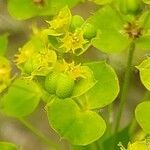Herbs, erect, (15-)30-60 cm tall. Rootstock enlarged or sometimes extensively rhizomatous, brown or dark brown, up to 20 cm × 3-5(-6) mm, branched or not. Stems single or clustered, many branched basally, 3-5 mm thick; sterile stems sometimes present, sometimes overtopping inflorescence. Leaves alternate, often larger toward stem apex; stipules absent; basal scale-leaves few; petiole absent; leaf blade linear to ovate, very variable, (1.5-)2-7 × (0.15-)0.4-0.7(-1.2) cm, base attenuate, cuneate, or truncate, apex acuminate or acute; leaves on sterile branches denser, needlelike, 2-3 × ca. 0.1 cm. Inflorescence a terminal pseudumbel, often with lateral cymes from axils below; cymes mostly dichotomous; primary involucral leaves 3-8, similar to normal leaves to almost orbicular, primary rays 3-8, 2-4(-5) cm; cyathophylls 2, sometimes overlapping at base, usually reniform, occasionally ovate or triangular-ovate, pair often forming complete circle, 0.4-1.2 × 0.4-1 cm, base subtruncate to shallowly cordate, apex shortly acuminate to rounded. Cyathium sessile; involucre campanulate, ca. 3 × 2.5-3 mm, lobes rounded to triangular, tomentose on margin and inside; glands 4, brown, crescent-shaped, usually 2-horned, horns long and acute to short and obtuse or absent, sometimes so tightly incurved that gland looks circular. Bracteoles linear, glabrous. Male flowers many. Female flower: ovary exserted from cup, smooth, glabrous; styles free, persistent; style arms 2-lobed. Capsule trigonous-globose, 5-6 × 5-6 mm, with 3 vertical furrows. Seeds ovoid-globose, 2.5-3 × 2-2.5 mm, yellow-brown; caruncle present, peltate, sessile. Fl. and fr. Apr-Oct. 2n = 40*.
More
Strong-rooted, vigorously colonial perennial, erect, 3–7 dm, glabrous, usually with numerous alternate flowering branches below the umbel; cauline lvs linear to lance-linear or narrowly oblanceolate, mostly 3–8 cm × 3–8 mm, obtuse to mucronate, essentially 1-nerved, the lateral veins very obscure, leaving the midrib at an angle of 15–35°; lvs subtending the umbel shorter and broader, lanceolate to ovate, those of the umbel opposite, broadly cordate or reniform; rays of the primary umbel mostly 7–15; fr 3–3.5 mm, finely granular; seeds ellipsoid, 2–2.5 mm; 2n=20, 60, 64. Native of Eurasia, widely established in N. Amer. from New England to the Pacific, s. to Md., Ind., Io., and Colo. Summer. (Tithymalus e.; Galarhoeus e.; Euphorbia intercedens; E. podperae; E. virgata, at least as applied to N. Amer. plants)
A small herb. It grows 15-60 cm high. It has tough deep roots and keeps growing from these from year to year. The leaves are alternate and narrowly oblong. They are scattered along the stem and in rings at the top. The flower is yellowish-green and they are in heads. The male and female flowers are on a pair of leaf like bracts. The fruit is a dry capsule. It has 3 seeds.
